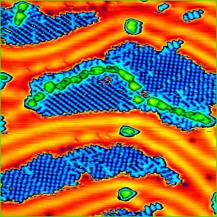We have shown using STM that adsorbing NO2 molecules induces massively cooperative restructuring of Au{111} at 90 K, leading to the formation of Au nanoclusters. NO2 islands nucleate at the elbows of the clean-surface "herringbone" reconstruction pattern, and grow into the adjacent stripe domains along the fcc strips. Neighbouring islands grow alternately to one side and the other of the domain boundary, in a form of mesoscopic self-organisation driven by changes in surface stress around the islands. Evidence of the local stress fields around the islands can be seen in bowing of the soliton walls adjacent to the islands.
As the NO2 coverage increases, the islands start to coalesce and the reconstruction is locally lifted. The Au atoms ejected in this process, rather than diffusing to neighbouring steps, aggregate together into nano-clusters, each containing 4-5 Au atoms. A string of these nano-clusters marks the final position of the bowed soliton wall from which the Au atoms were ejected. Because this process is only triggered when the islands have grown to contain some 300 molecules each, and involves the concerted movement of around 100 Au atoms, we describe this as a "massively cooperative" restructuring process.
Once the NO2 layer is saturated, we expose it at temperatures between 90 and 115 K to CO. The presence of NO2 turns out to stabilise CO on the Au{111} surface: it would not otherwise adsorb at these temperatures. Although the interaction with CO is weak, it causes re-arrangement of the NO2 layer into one of a series of co-adsorbed structural phases, dependent on stoichiometry. This was unexpected and intriguing; electronegative species, if anything, typically act as poisons to adsorption. DFT calculations predict that other electronegative species, such as S, will have a similar effect. We are actively following this up through further experiments as a possible route to new low-temperature catalytic processes.
 |
STM image showing islands of NO2 molecules (blue) on Au{111} (orange) at 78 K. Local lifting of the "herringbone" reconstruction causes the formation of a string of Au nano-clusters (green), each containing 4-5 Au atoms. Image size 30x30 nm2. |
